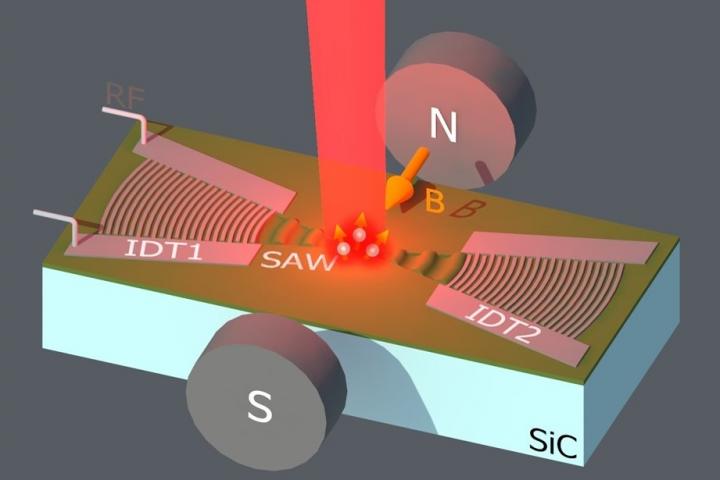
Credit: A. Hernandez-Minguez
Researchers from the Paul-Drude-Institut in Berlin, the Helmholtz-Zentrum in Dresden and the Ioffe Institute in St. Petersburg have demonstrated the use of elastic vibrations to manipulate the spin states of optically active color centers in SiC at room temperature. They show a non-trivial dependence of the acoustically induced spin transitions on the spin quantization direction, which can lead to chiral spin-acoustic resonances. These findings are important for applications in future quantum-electronic devices and have recently been published in Physical Review Letters.
Color centers in solids are optically active crystallographic defects containing one or more trapped electrons. Of special interest for applications in quantum technologies are optically addressable color centers, that is, lattice defects whose electronic spin states can be selectively initialized and read-out using light. In addition to initialization and read-out, it is also necessary to develop efficient methods to manipulate their spin states, and thus the information stored in them. While this is typically realized by applying microwave fields, an alternative and more efficient method could be the use of mechanical vibrations. Among the different materials for the implementation of such strain-based technologies, SiC is attracting growing attention as a robust material for nano-electromechanical systems with an ultrahigh sensitivity to vibrations that also hosts highly-coherent optically active color centers.
In a recent work published in Physical Review Letters, researches from the Paul-Drude-Institut fuer Festkoerperelektronik, the Helmholtz-Zentrum Dresden-Rossendorf and the Ioffe Institute have demonstrated the use of elastic vibrations to manipulate the spin states of optically active color centers in SiC at room temperature. In their study, the authors use the periodic modulation of the SiC crystal lattice to induce transitions between the spin levels of the silicon-vacancy center, an optically active color center with spin S=3/2. Of special importance for future applications is the fact that, in contrast to most atom-like light centers, where the observation of strain-induced effects requires cooling the system to very low temperatures, the effects reported here were observed at room temperature.
To couple the lattice vibrations to the silicon-vacancy centers, the authors first selectively created such centers by irradiating the SiC with protons. Then they fabricated an acoustic resonator for the excitation of standing surface acoustic waves (SAW) on the SiC. SAWs are elastic vibrations confined to the surface of a solid that resemble seismic waves created during an earthquake. When the frequency of the SAW matches the resonant frequencies of the color centers, the electrons trapped in them can use the energy of the SAW to jump between the different spin sublevels. Due to the special nature of the spin-strain coupling, the SAW can induce jumps between spin states with magnetic quantum number differences Δm=±1 and Δm=±2, while microwave-induced ones are restricted to Δm=±1. This allows to realize full control of the spin states using high-frequency vibrations without the aid of external microwave fields.
In addition, due to the intrinsic symmetry of the SAW strain fields combined with the peculiar properties of the half-integer spin system, the intensity of such spin transitions depends on the angle between SAW propagation and spin quantization directions, which can be controlled by an external magnetic field. Moreover, the authors predict a chiral spin-acoustic resonance under traveling SAWs. This means that, under certain experimental conditions, the spin transitions can be switched on or off by inverting the magnetic field or the SAW propagation direction.
These findings establish silicon carbide as a highly promising hybrid platform for on-chip spin-optomechanical quantum control enabling engineered interactions at room temperature.
###
Media Contact
Dr. Alberto Hernández-Mínguez
[email protected]
Original Source
https:/
Related Journal Article
http://dx.




